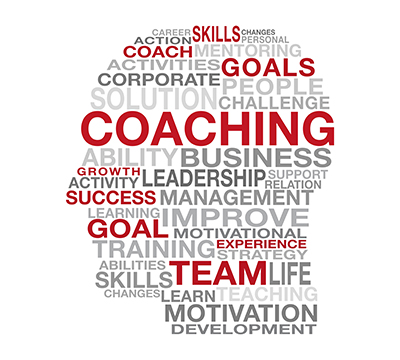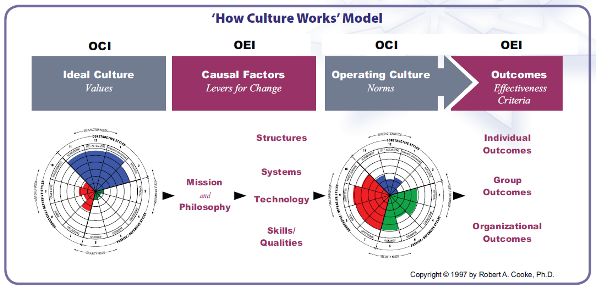Below an inspiring article about how to shape a high-performance culture by Susan Camberis, Vice President of Learning & Organizational Development at Executive Coaching Connections, LLC
The article is based on research, tools and methodology developed by Human Synergistics, e.g. the model below.
If you want to hear more about the Human Synergistic research and/or tools don't hesitate to contact me on [email protected]. This organisation and their tools are among the the best I've ever worked with!
The article is based on research, tools and methodology developed by Human Synergistics, e.g. the model below.
If you want to hear more about the Human Synergistic research and/or tools don't hesitate to contact me on [email protected]. This organisation and their tools are among the the best I've ever worked with!
Most leaders know that culture matters. But, did you know that the narrower the culture gap (the difference between current and preferred cultures) the more likely it is that high potential employees will stay?
According to recent research by The Catalyst Center for Career Pathways, the narrower the culture gap, the more satisfied high potentials are with their work and advancement, pay, managers, and organizational commitment to work-life quality and diversity. “A narrower culture gap and greater employee satisfaction combine to predict high potentials’ intention to stay,” according to Catalyst. The report continues, “Women and men high potentials agree on workplace culture: Both would prefer to work in cultures that are more constructive and less aggressive. Both agree that the biggest gap in their workplace cultures is that they are not constructive enough.”
Related research from Human Synergistics International (HSI), a pioneer in the field of workplace culture, shows that constructive cultural norms correlate positively with financial performance, teamwork, motivation, adaptability, and reduced stress.
According to recent research by The Catalyst Center for Career Pathways, the narrower the culture gap, the more satisfied high potentials are with their work and advancement, pay, managers, and organizational commitment to work-life quality and diversity. “A narrower culture gap and greater employee satisfaction combine to predict high potentials’ intention to stay,” according to Catalyst. The report continues, “Women and men high potentials agree on workplace culture: Both would prefer to work in cultures that are more constructive and less aggressive. Both agree that the biggest gap in their workplace cultures is that they are not constructive enough.”
Related research from Human Synergistics International (HSI), a pioneer in the field of workplace culture, shows that constructive cultural norms correlate positively with financial performance, teamwork, motivation, adaptability, and reduced stress.
How do you build a constructive culture?
One often-overlooked way is through Coaching.
Progressive organizations regularly use coaching with high potential leaders and teams. Coaches help clients optimize their leadership by clarifying expectations, supporting introspection, planning for development, and holding clients accountable. Because of their unique perspectives, coaches can help enhance leaders’ abilities to model new behaviors and enable them to see their teams and organizations in new ways.
Coaches can also help clients understand culture fundamentals and, where appropriate, connect specific behavior change to enhancing the culture of their organization. Tim Kuppler, Director of Culture and Organization Development for Human Synergistics, described it this way in an ECC Discover Blog post this month, “It’s critical to understand the ‘culture fundamentals.’” This includes the importance of connecting culture to a top challenge, goal or problem.
When culture is connected to enablement of business strategy, the questions become: What do we want people to think, feel, or do differently? What’s important to us? What are our new behavioral norms?
Four cultural norms support constructive cultures: Achievement, Self-Actualizing, Humanistic-Encouraging, and Affiliative. Here’s how coaching enhances each and a few thought-starters to encourage these norms in your organization:
Progressive organizations regularly use coaching with high potential leaders and teams. Coaches help clients optimize their leadership by clarifying expectations, supporting introspection, planning for development, and holding clients accountable. Because of their unique perspectives, coaches can help enhance leaders’ abilities to model new behaviors and enable them to see their teams and organizations in new ways.
Coaches can also help clients understand culture fundamentals and, where appropriate, connect specific behavior change to enhancing the culture of their organization. Tim Kuppler, Director of Culture and Organization Development for Human Synergistics, described it this way in an ECC Discover Blog post this month, “It’s critical to understand the ‘culture fundamentals.’” This includes the importance of connecting culture to a top challenge, goal or problem.
When culture is connected to enablement of business strategy, the questions become: What do we want people to think, feel, or do differently? What’s important to us? What are our new behavioral norms?
Four cultural norms support constructive cultures: Achievement, Self-Actualizing, Humanistic-Encouraging, and Affiliative. Here’s how coaching enhances each and a few thought-starters to encourage these norms in your organization:
Achievement
Human Synergistics defines the Achievement norm as: “Members are expected to set challenging goals, establish plans to reach those goals, and pursue them with enthusiasm.”
Coaching naturally aligns with Achievement-related norms, because of its focus on helping leaders set SMART goals. By enhancing their own ability to set and achieve goals, leaders become stronger role models for their teams and the broader organization. Coaches can be instrumental in helping clients connect specific development actions with organizational goals.
To encourage the Achievement norm, consider:
Coaching naturally aligns with Achievement-related norms, because of its focus on helping leaders set SMART goals. By enhancing their own ability to set and achieve goals, leaders become stronger role models for their teams and the broader organization. Coaches can be instrumental in helping clients connect specific development actions with organizational goals.
To encourage the Achievement norm, consider:
- How involved are team members in setting their own goals?
- Are all goals supported by clear strategies and actions?
- How closely are individual development goals tied back to organizational goals and priorities? How much ‘stretch’ is built in?
- How regularly is feedback given on progress toward achieving goals?
Self-Actualizing
HSI describes the Self-Actualizing norm as: “Members are expected to enjoy their work, develop themselves, and take on new and interesting activities.”
Development is a central part of coaching, and a ‘development plan’ is often a key deliverable of any coaching engagement. Here’s where the ‘rubber meets the road,’ in terms of a leader’s ability to integrate what they’ve learned from introspection into day-to-day constructive leadership practices.
To enhance the Self-Actualizing norm, encourage team members to think about:
Development is a central part of coaching, and a ‘development plan’ is often a key deliverable of any coaching engagement. Here’s where the ‘rubber meets the road,’ in terms of a leader’s ability to integrate what they’ve learned from introspection into day-to-day constructive leadership practices.
To enhance the Self-Actualizing norm, encourage team members to think about:
- What do you enjoy most about your current work?
- What new project are you working on? What do you find interesting about it?
- What is your top development goal? How will achieving this goal enable you to contribute differently to the organization?
- What could help you accomplish this goal more quickly?
Humanistic-Encouraging
The Humanistic-Encouraging norm is described by HSI as: “Members are expected to be supportive, constructive, and open to influence in their dealings with one another.”
Coaching can help leaders understand the influence of their mental models. Mental models are the underlying patterns of perceptions, thoughts and emotions that guide our behaviors and actions. Mental models can serve, drive, and support us, but, they can also get in our way and cause missed opportunities. By helping leaders understand, examine, challenge, and re-frame their mental models, coaches empower clients to gain new insights into how their underlying views may be influencing their behaviors and affecting the culture of their organization.
To support others in developing the Humanistic-Encouraging norm, ask:
Coaching can help leaders understand the influence of their mental models. Mental models are the underlying patterns of perceptions, thoughts and emotions that guide our behaviors and actions. Mental models can serve, drive, and support us, but, they can also get in our way and cause missed opportunities. By helping leaders understand, examine, challenge, and re-frame their mental models, coaches empower clients to gain new insights into how their underlying views may be influencing their behaviors and affecting the culture of their organization.
To support others in developing the Humanistic-Encouraging norm, ask:
- How supported do you feel in your role?
- How comfortable do you feel in expressing your ideas and suggestions?
- What would make you feel more open to express your ideas and suggestions?
- What small change could potentially make a big impact in improving openness on the team?
Affiliative
According to HSI, the Affiliative norm is described as: “Members are expected to be friendly, cooperative, and sensitive to the satisfaction of their work group.”
Coaching enhances Affiliative behaviors by helping leaders assess work group satisfaction. As leaders become more aware of the impact of their own behavior on others (through introspection, feedback, and targeted coaching), they also enhance their awareness of the needs of others.
To enhance development of the Affiliative norm, consider:
In addition to optimizing high performance in leaders and teams, coaching can help organizations shape constructive cultures that retain high-potential talent.
Coaching enhances Affiliative behaviors by helping leaders assess work group satisfaction. As leaders become more aware of the impact of their own behavior on others (through introspection, feedback, and targeted coaching), they also enhance their awareness of the needs of others.
To enhance development of the Affiliative norm, consider:
- How well do team members cooperate with one another?
- How satisfied do team members feel with being a part of the team?
- What would encourage greater cooperation on the team?
- If you could change one thing about the team, what would it be?
In addition to optimizing high performance in leaders and teams, coaching can help organizations shape constructive cultures that retain high-potential talent.
For more information
If you're interested in hearing more about the HSI tools and research, don't hesitate to reach out to me on: [email protected]


 RSS Feed
RSS Feed